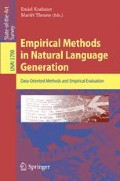Abstract
Since the early days of generation research, it has been acknowledged that modeling the global structure of a document is crucial for producing coherent, readable output. However, traditional knowledge-intensive approaches have been of limited utility in addressing this problem since they cannot be effectively scaled to operate in domain-independent, large-scale applications. Due to this difficulty, existing text-to-text generation systems rarely rely on such structural information when producing an output text. Consequently, texts generated by these methods do not match the quality of those written by humans – they are often fraught with severe coherence violations and disfluencies.
In this chapter, I will present probabilistic models of document structure that can be effectively learned from raw document collections. This feature distinguishes these new models from traditional knowledge intensive approaches used in symbolic concept-to-text generation. Our results demonstrate that these probabilistic models can be directly applied to content organization, and suggest that these models can prove useful in an even broader range of text-to-text applications than we have considered here.
Access this chapter
Tax calculation will be finalised at checkout
Purchases are for personal use only
Preview
Unable to display preview. Download preview PDF.
References
Althaus, E., Karamanis, N., Koller, A.: Computing locally coherent discourses. In: Proceedings of the ACL, pp. 399–406 (2004)
Barzilay, R., Lapata, M.: Modeling local coherence: An entity-based approach. Computational Linguistics 34(1), 1–34 (2008)
Barzilay, R., Lee, L.: Catching the drift: Probabilistic content models, with applications to generation and summarization. In: HLT-NAACL, pp. 113–120 (2004)
Chen, H., Branavan, S., Barzilay, R., Karger, D.R.: Content modeling using latent permutations. JAIR, 129–163 (2009)
Elsner, M., Austerweil, J., Charniak, E.: A unified local and global model for discourse coherence. In: Proceedings of HLT-NAACL, pp. 436–443 (2007)
Fligner, M., Verducci, J.: Distance based ranking models. Journal of the Royal Statistical Society, Series B 48(3), 359–369 (1986)
Foltz, P.W., Kintsch, W., Landauer, T.K.: Textual coherence using latent semantic analysis. Discourse Processes 25(2&3), 285–307 (1998)
Grosz, B., Joshi, A.K., Weinstein, S.: Centering: A framework for modeling the local coherence of discourse. Computational Linguistics 21(2), 203–225 (1995)
Grosz, B.J., Sidner, C.L.: Attention, intentions, and the structure of discourse. Computational Linguistics 12(3), 175–204 (1986)
Halliday, M.A.K., Hasan, R.: Cohesion in English. Longman, London (1976)
Harris, Z.: Discourse and sublanguage. In: Kittredge, R., Lehrberger, J. (eds.) Sublanguage: Studies of Language in Restricted Semantic Domains, pp. 231–236. Walter de Gruyter, Berlin (1982)
Hasler, L.: An investigation into the use of centering transitions for summarisation. In: Proceedings of the 7th Annual CLUK Research Colloquium., pp. 100–107. University of Birmingham (2004)
Karamanis, N.: Exploring entity-based coherence. In: Proceedings of CLUK4, Sheffield, UK, pp. 18–26 (2001)
Karamanis, N., Poesio, M., Mellish, C., Oberlander, J.: Evaluating centering-based metrics of coherence for text structuring using a reliably annotated corpus. In: Proceedings of the ACL, pp. 391–398 (2004)
Kittredge, R., Korelsky, T., Rambow, O.: On the need for domain communication language. Computational Intelligence 7(4), 305–314 (1991)
Lapata, M.: Probabilistic text structuring: Experiments with sentence ordering. In: Proceedings of the ACL, pp. 545–552 (2003)
Lin, C.Y.: ROUGE: A package for automatic evaluation of summaries. In: Proceedings of ACL, pp. 74–81 (2004)
Mani, I., Maybury, M.T.: Advances in Automatic Text Summarization. The MIT Press, Cambridge (1999)
Mann, W.C., Thompson, S.A.: Rhetorical structure theory: Toward a functional theory of text organization. TEXT 8(3), 243–281 (1988)
Marcu, D.: The rhetorical parsing of natural language texts. In: Proceedings of the ACL/EACL, pp. 96–103 (1997)
Marcu, D.: The Theory and Practice of Discourse Parsing and Summarization. MIT Press, Cambridge (2000)
McKeown, K.R.: Text Generation: Using Discourse Strategies and Focus Constraints to Generate Natural Language Text. Cambridge University Press, Cambridge (1985)
Miltsakaki, E., Kukich, K.: The role of centering theory’s rough-shift in the teaching and evaluation of writing skills. In: Proceedings of the ACL, pp. 408–415 (2000)
Poesio, M., Stevenson, R., Eugenio, B.D., Hitzeman, J.: Centering: a parametric theory and its instantiations. Computational Linguistics 30(3), 309–363 (2004)
Rambow, O.: Domain communication knowledge. In: Fifth International Workshop on Natural Language Generation, pp. 87–94 (1990)
Sauper, C., Barzilay, R.: Automatically generating wikipedia articles: A structure-aware approach. In: Proceedings of the ACL/IJCNLP, pp. 208–216 (2009)
Sproat, R.: Morphology and Computation. MIT Press, Cambridge (1993)
Author information
Authors and Affiliations
Editor information
Editors and Affiliations
Rights and permissions
Copyright information
© 2010 Springer-Verlag Berlin Heidelberg
About this chapter
Cite this chapter
Barzilay, R. (2010). Probabilistic Approaches for Modeling Text Structure and Their Application to Text-to-Text Generation. In: Krahmer, E., Theune, M. (eds) Empirical Methods in Natural Language Generation. EACL ENLG 2009 2009. Lecture Notes in Computer Science(), vol 5790. Springer, Berlin, Heidelberg. https://doi.org/10.1007/978-3-642-15573-4_1
Download citation
DOI: https://doi.org/10.1007/978-3-642-15573-4_1
Publisher Name: Springer, Berlin, Heidelberg
Print ISBN: 978-3-642-15572-7
Online ISBN: 978-3-642-15573-4
eBook Packages: Computer ScienceComputer Science (R0)

